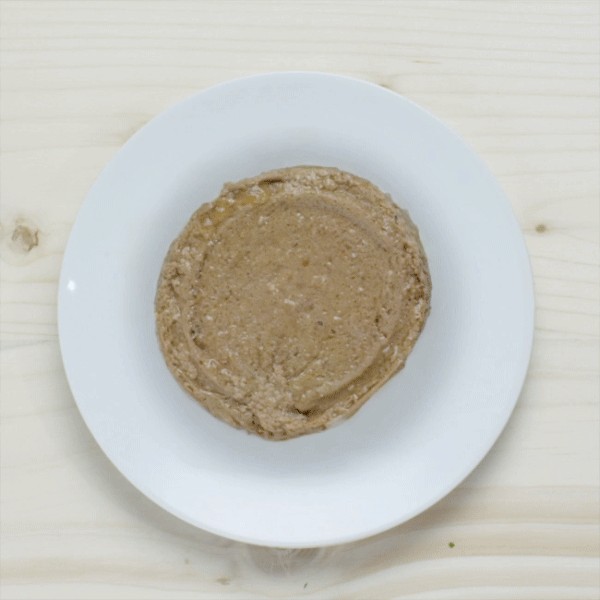Cats are notoriously picky eaters. While we might judge our food by its visual appeal, cats rely more on smell and “mouth-feel.” Understanding your cat’s preferences, especially when it comes to wet food textures like pate, is key to keeping them happy and healthy. This guide dives into the world of pate cat food, exploring its characteristics, benefits, and how to find the perfect pate for your feline friend.
Understanding Feline Food Preferences
Unlike humans with our 9,000 taste buds, cats have only around 500. This means flavor plays a smaller role in their food choices. Instead, a cat’s sense of smell (with 65 million olfactory receptors compared to our 15 million) and the texture of the food are the primary drivers of their preference. The “mouth-feel” – how easily they can pick up the food and how it feels in their mouth – is especially important. Positive experiences after the meal, like grooming and settling down for a nap, further reinforce these preferences.
Alt text: Smooth pate cat food in a can, showing its uniform texture.
The Importance of Early Exposure
A cat’s early experiences with food significantly shape their adult preferences. Kittens raised in diverse environments with varied food options are more likely to be open to new foods as adults. Exposing kittens to both dry and wet food, and a range of wet food textures like pate, morsels, gravies, and shreds, can prevent them from becoming overly selective eaters.
There are also health benefits to a varied diet. Dry food can help maintain dental hygiene through its abrasive texture, while wet food provides essential moisture, which is especially important for cats who don’t have a strong thirst drive. A combination of both can offer the best of both worlds.
What is Pate Cat Food?
Pate cat food is characterized by its completely smooth and uniform consistency. It’s essentially a finely ground blend of ingredients, making it easy for cats to eat and digest. Pate textures can vary in firmness and creaminess, with some being softer and more spreadable than others.
Benefits of Pate Cat Food:
- Easy to Eat: Its smooth texture is ideal for kittens, senior cats, or cats with dental issues who might have difficulty chewing other types of food.
- Hydration: Wet food, including pate, has a high moisture content, which is crucial for maintaining your cat’s hydration levels.
- Palatability: Many cats find pate highly palatable, making it a good option for picky eaters or cats with reduced appetites.
- Nutrient-Rich: Pate cat foods are often packed with essential nutrients, vitamins, and minerals to support your cat’s overall health.
Exploring Other Wet Cat Food Textures
While pate is a popular choice, it’s important to remember that cats have individual preferences. Exploring other textures can help you find the perfect fit for your feline companion. Here’s a brief overview of other common wet cat food textures:
- Minced: Tiny chopped pieces of protein served in a light gravy.
Alt text: Minced cat food showing small, crumbly pieces in gravy.
- Gravies: Small, irregular pieces of protein in a thick gravy base.
Alt text: Wet cat food with small protein pieces mixed in a thick gravy.
- Morsels (Cubed): Distinctive cube-shaped protein pieces served in a light gravy.
Alt text: Cubed or morsel cat food, showing cube-shaped protein in gravy.
- Flaked: Long, thin, flat pieces of fish in broth.
Alt text: Flaked cat food with long, thin pieces of fish in broth.
- Chunky: Thick chunks of protein in a thick sauce with some small shreds of meat dispersed throughout.
Alt text: Chunky cat food featuring thick chunks of protein in a sauce.
- Shredded: Long, thin pieces of meat in varying widths, served in light gravy.
Alt text: Shredded cat food with long, thin pieces of meat in gravy.
- Hearty Cuts: Longer and narrower cuts of meat, served in light gravy.
Alt text: Hearty cuts cat food showcasing long, narrow cuts of meat in gravy.
Conducting a Food Trial
Finding the right wet food texture for your cat may require some experimentation. Consider conducting a food trial by offering small amounts of different textures to see which one your cat prefers. Many brands offer variety packs or individual servings, allowing you to test different options without committing to a large quantity.
Creating a Positive Mealtime Experience
Beyond the food itself, the mealtime environment also plays a crucial role in your cat’s eating habits. Here are some tips for creating a positive mealtime experience:
- Location: Place the food bowl in a quiet, low-traffic area where your cat feels safe and secure.
- Hygiene: Wash the food bowl after every meal to prevent bacteria buildup.
- Bowl Shape: Opt for shallow, wide bowls that allow your cat to eat comfortably without their whiskers touching the sides.
- Frequency: Consider offering multiple small meals throughout the day, as this mimics a cat’s natural eating behavior.
- Smart Bowls: In multi-pet households, consider using a microchip-activated food bowl to ensure each cat receives their designated portion.
Conclusion
Understanding your cat’s individual preferences is essential for providing them with a healthy and enjoyable diet. While pate cat food is a popular and often beneficial choice, exploring other textures and creating a positive mealtime environment can further enhance your cat’s overall well-being. By paying attention to your cat’s cues and experimenting with different options, you can find the perfect food to keep them happy, healthy, and purring with satisfaction.
Alt text: A contented cat snuggling, highlighting the post-meal satisfaction of a good diet.
